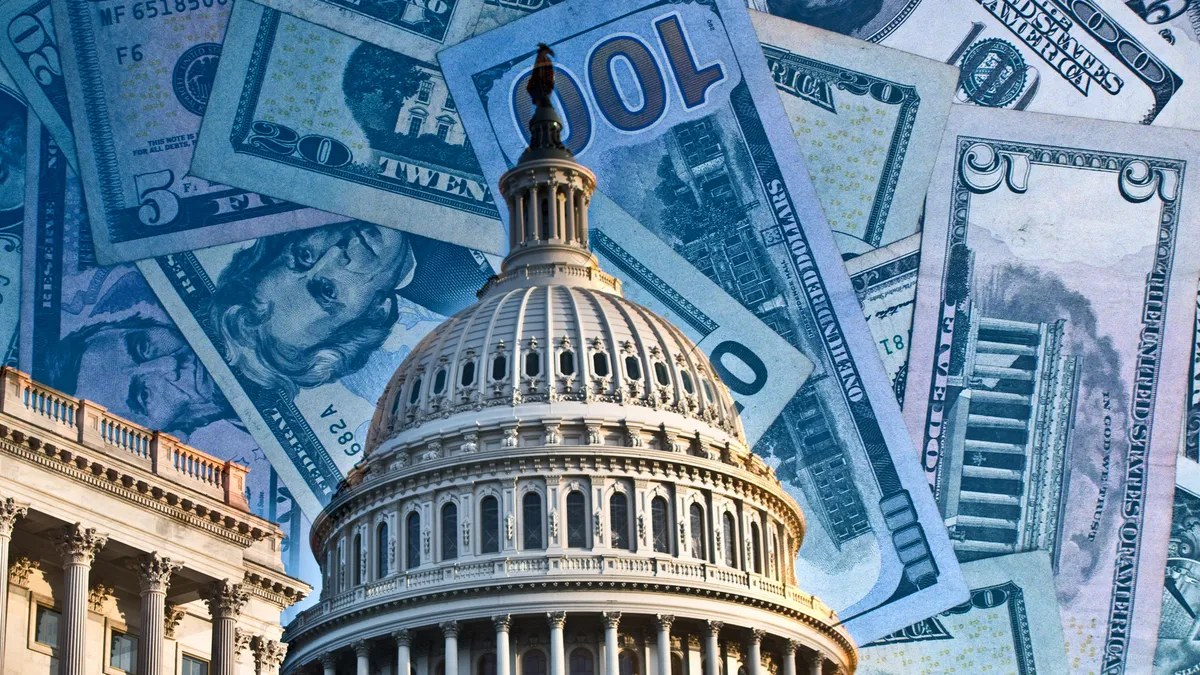Dive Brief:
- While early top spending categories from federal relief money focused on mitigating COVID-19 spread and making investments in technology and broadband, the third and last allotment of funding concentrated on addressing learning loss, a survey of school district finance leaders shows.
- The survey, released Tuesday by the Association of School Business Officials International, also found two-thirds of respondents said their district received $3,000 or less per student in total from the Elementary and Elementary and Secondary School Emergency Relief funding.
- The data gives insights into both the challenges and benefits of the largest one-time federal investment in K-12 schools and how spending priorities shifted as students returned after extended closures. The results also show how the lingering and unpredictable pandemic is driving spending decisions and how a looming obligation deadline of Sept. 30, 2024, under the American Rescue Plan — the third and last allotment of relief funding — could influence spending goals.
Dive Insights:
Balancing the realities of COVID-19 safety expenditures with ambitious investments for learning recovery has been the aim throughout the three ESSER allocations, known as ESSER I, ESSER II and ESSER III (ARP).
The ASBO survey, however, shows it was when schools had access to ARP funding — the largest of the ESSER allocations at $121.9 billion — that they could make more progress in dedicating aid for academic and mental health supports.
For example, 71% of survey respondents said that for ESSER I funding, which equaled $13.2 billion, the top spending category was procuring personal protective equipment, cleaning and sanitation supplies, and training staff on COVID-19 safety precautions. For ESSER III funds, only 18% of respondents called those items a top spending category.
For ESSER I money, 29% of respondents said addressing learning loss through summer school, after-school and tutoring activities was a top spending category. But for ESSER III budget planning, 54% said it was the top expenditure category.
Although districts are required to spend at least 20% of ESSER III funding on academic recovery supports, the shift in spending also demonstrates how concerned local education leaders are about pandemic-related academic setbacks, said an ASBO report about the survey results.
The survey includes responses from finance leaders at 154 school districts across 35 states. A majority of respondents said they serve a rural (44%) or suburban district (41%). Two-thirds serve school districts with fewer than 5,000 students.
The ASBO report suggests that sharing of best-practice approaches to avoid fiscal cliffs and recommended one-time investments to support student pandemic-related recovery would be helpful to district leaders.
"Policymakers and other stakeholders seek information about how districts are spending federal funds to accelerate student learning, address emergency mental health and social-emotional needs, and implement other COVID-19 school recovery strategies," said David Lewis, executive director of ASBO, in a statement.
While survey respondents said ARP funding has allowed them to be creative in pursuing academic interventions for students — especially those who have been historically underserved — one in six respondents said they face delays in carrying out improvement goals because their state had yet to approve their plans as of Jan. 31.
The U.S. Department of Education announced in January that all ARP state-level plans were approved. In turn, districts were required to create local ARP spending plans to submit to their state. States were required to distribute ESSER I and II funding to districts within one year of receipt of receiving the federal funds. For ARP money, states had to send funds to districts in an "expedited and timely manner and, to the extent practicable, not later than 60 days after the SEA receives the award," according to Education Department guidance from May 2021.
Respondents voiced concerns about spending challenges including ensuring sustainable investments, avoiding a fiscal cliff, the competing priorities of spending quickly and strategically, supply chain hurdles, inability to meet spending deadlines for long-term projects and more.
According to the U.S. Department of Education, spending reports as of March 31 show states and their districts have used between 7.4% (Nevada) and 35.7% (Iowa) of total ESSER funding. The ESSER I obligation deadline is Sept. 30, 2022, and ESSER II funds must be obligated by Sept. 30, 2023. The Congressional Budget Office estimates that ESSER spending outlays could extend to 2028.
But timeframes for when school systems commit to expenditures — or obligating funds — and actually pay for purchases or contracts is confusing to some. AASA, The School Superintendents Association, is asking the Education Department to provide more clarity on this issue, said Sasha Pudelski, AASA's advocacy director.
AASA is also hoping Congress will consider extending the Sept. 30, 2024, ARP obligation deadline, Pudelski said. This is a change that can only be made by Congress, according to meetings the group has had with lawmakers and the Ed Department, she said.
Because of staffing shortages and the continuing impacts of the pandemic, "there still could be, for some school districts, a need to extend the obligation timeline," Pudelski said.







 Dive Awards
Dive Awards






